Enhanced Corrosion Resistance of CuAl/BN Coatings through the Addition of Rare Earth Elements and High-Temperature Oxidation Treatment
Abstract
:1. Introduction
2. Experimental Procedure
2.1. Materials
2.2. Preparation and Material Testing
2.2.1. Preparation Method for the Coating
2.2.2. Microstructure and Composition Characterization
2.2.3. Coating Hardness and Bonding Strength
2.2.4. Salt-Spray Corrosion Test
2.2.5. Electrochemical Testing
3. Results and Discussions
3.1. Morphology and Microstructure Results
3.2. Effect of Rare Earth Additions on the Electrochemistry of CuAl/BN Coatings
3.2.1. Open-Circuit Potential and Polarization Curve Testing
3.2.2. EIS Testing
3.3. Changes in the Organization and Morphology of the Coatings after Salt-Spray Corrosion
3.4. Coating Bond Strength
3.5. 550 °C Oxidation Pretreatment of the Coating
3.5.1. Electrochemical Characterization of the Coatings after Oxidation Pretreatment
3.5.2. Coating Bond Strength after Oxidation Pretreatment
4. Conclusions
Author Contributions
Funding
Data Availability Statement
Conflicts of Interest
References
- Ma, R.; Liu, M. Research Progress on Preparation and Performance Evaluation of Seal Coatings in Titanium-Fire Retardant Coatings for Aero Engines. Mater. Prot. 2021, 54, 145–152. [Google Scholar]
- Cheng, T.; Wang, Z.; Dai, S.; Ding, K.; Ma, X. Research Progress of Ceramic-based High Temperature Sealing Coating for Aeroengines. J. Mech. Eng. 2021, 57, 126. [Google Scholar]
- Huang, W. Study of Preparation and Properties of Abradable Composite Seal Coating used in High Temperature. Master’s Thesis, Wuhan University of Technology, Wuhan, China, 2011. [Google Scholar]
- Dai, H.; Wang, L.; Zhang, J.; Wang, L.; Yang, Z.; Zhang, J.; Lin, F. Research and Prospect of Novel High-Temperature Thermal Resistant Abradable Sealing Coating. Mater. Rev. 2008, 22, 18–21. [Google Scholar]
- Wang, T.; Chen, S.; Meng, K.; Liu, X. Research Progress on Structural Designs and Preparations of Sealing Coating Between Aero-engine Casing and Blade Tip. China Surf. Eng. 2023, 36, 1–11. [Google Scholar]
- Su-Wei, L.U.; Shu, L.I.; Yang, L.U. Seal Coating and Evaluation of Its Abradability. China Surf. Eng. 2009, 22, 12. [Google Scholar]
- Zhang, F.; Xu, C.; Lan, H.; Huang, C.; Zhou, Y.; Du, L.; Zhang, W. Corrosion Behavior of an Abradable Seal Coating System. J. Therm. Spray Technol. 2014, 23, 1019–1028. [Google Scholar] [CrossRef]
- Xu, C.; Du, L.; Zhang, W.; Yang, B.; Wang, L.; Li, J. Salt Spray Corrosion of Ni/Graphite Abradable Sealing Coatings. J. Aeronaut. Mater. 2010, 30, 53–58. [Google Scholar]
- Lei, B.; Li, M.; Zhao, Z.; Wang, L.; Li, Y.; Wang, F. Corrosion Mechanism of an Al-BN abradable Seal Coating System in Chloride Solution. Corros. Sci. 2014, 79, 198–205. [Google Scholar] [CrossRef]
- Yu, F.L.; Bai, Y.; Wu, X.Y.; Wang, H.; Wu, J. Corrosion Resistance and Anti-wear Property of Nickel Based Abradable Sealing Coating Deposited by Plasma Spraying. J. Inorg. Mater. 2016, 31, 687–693. [Google Scholar]
- Yumeng, N.I.; Yingjie, Y.U.; Hui, Y.A.N.; Wei, W.A.N.G.; Ying, L.I. Finite Element Study on Phase-selective Dissolution Mechanism of CuAl-NiC Abradable Seal Coating. J. Chin. Soc. Corros. Prot. 2023, 43, 855–861. [Google Scholar]
- Yan, H.; Yu, Y.; Song, Y.; Lei, B.; Ni, Y.; Tang, A.; Li, Y. An Abradable and Anti-corrosive CuAl-Ni/C Seal Coating for Aero-engine. Chem. Eng. J. 2023, 474, 145665. [Google Scholar] [CrossRef]
- Ni, Y.; Zhang, F.; Njoku, D.I.; Yu, Y.; Pan, J.; Meng, M.; Li, Y. Corrosion Mechanism of CuAl-NiC abradable Seal Coating System-The Influence of Porosity, Multiphase, and Multilayer Structure on the Corrosion Failure. J. Mater. Sci. Technol. 2021, 88, 258–269. [Google Scholar] [CrossRef]
- Zhang, S.; Sun, W.; Liu, T.; Yang, J.; Liu, J.; Wu, C.; Ouyang, P. Preparation and Performance Evolution of Plasma Sprayed Abradable CuAl/PHB-NiAl Layered Seal Coatings. Materials 2023, 16, 227. [Google Scholar] [CrossRef]
- Liu, P.; Li, H.; Zhang, Y. Effect of Rare Earth Element (RE) Oxides on Diffusive Behaviour and Wear Resistance of a Laser Clad TiC/TiB Reinforced Coating on a Ti-3Al-2V Alloy. Materials 2014, 26, 381–390. [Google Scholar]
- Wang, S.C.; Chou, C.P. Effect of Adding Sc and Zr on Grain Refinement and Ductility of AZ31 Magnesium Alloy. J. Mater. Process. Technol. 2008, 197, 116–121. [Google Scholar] [CrossRef]
- Yang, N.; Long, J. Rare Earth Metal Passivation—A New Green Technology of Surface Treatment for Corrosion Protection. Chin. Rare Earths 2002, 23, 55–62. [Google Scholar]
- Chen, D.; Fan, H.; Chen, Z.; Ni, X. The Application and Developments of Rare-earth Elements in Surface Treatments of Aluminum Alloy. Surf. Technol. 2007, 36, 58–60. [Google Scholar]
- Lin, D.; Li, Y.; Chen, Y.; Cai, J.; Zheng, Y. Researches on the Application of Rare Earths in Anticorrosion of Aluminum Alloy. Chin. Rare Earths 2016, 37, 121–127. [Google Scholar]
- Lei, Z.; Wen, S.; Huang, H.; Wei, W.; Nie, Z. Grain Refinement of Aluminum and Aluminum Alloys by Sc and Zr. Metals 2023, 13, 751. [Google Scholar] [CrossRef]
- Tian, W.; Hu, M.; Sun, Y.; Bi, L. Research Progress on Effects of Rare Earth Elements on Properties of Al-Cu alloy. Trans. Mater. Heat Treat. 2019, 40, 12–19. [Google Scholar]
- Czerwinski, F. Cerium in Aluminum Alloys. J. Mater. Sci. 2020, 55, 24–72. [Google Scholar] [CrossRef]
- Fu, X.M.; Jiang, J.X.; Jiang, X.S. Research Progress in Interfacial Characteristics and Strengthening Mechanisms of Rare Earth Metal Oxide-Reinforced Copper Matrix Composites. Materials 2022, 15, 5350. [Google Scholar] [CrossRef] [PubMed]
- Zhu, R.; Zhang, J.; Shi, F.; Shang, X.; Wang, J.; Wang, J.; Tian, Y. Research Progress on Functional Mechanisms of Rare Earth Elements in Copper. Trans. Mater. Heat Treat. 2022, 43, 1–8. [Google Scholar]
- Song, J.; Bai, Z.; Li, Z.; Yao, Q.; Zhang, D.; Dong, C.; Xiao, K. Effect of Mg and RE on the Corrosion Resistance of Electric Arc Spraying ZnAl Alloy Coatings. Mater. Prot. 2020, 53, 1–7. [Google Scholar]
- Xing, S.; Xiao, K.; Li, L.; Li, X.; Liu, A.; Wang, E. Corrosion Resistance of Zn-Al-Mg-La-Ce Coatings by Electric Arc Spraying. J. Univ. Sci. Technol. Beijing 2012, 34, 1167–1172. [Google Scholar]
- Fu, D.X.; Xu, B.S.; Zhang, W.; Li, Q.; Wei, S. Action Mechanism of Self-sealing Behavior of Zn-Al-Mg-RE Coating in a Multilayer Coating. Trans. Mater. Heat Treat. 2007, 28, 98–101. [Google Scholar]
- Zhu, Z.X.; Zhang, J.; Xu, B.S. Effect of RE on Anti-corrosion Mechanism of Arc Sprayed Zn-Al-Mg Coatings. In Proceedings of the International Conference on Material Engineering, Shanghai, China, 28–30 October 2011. [Google Scholar]
- Deng, T.; Zhong, X.; Zhong, M.; Lai, Y.; Zhu, Z.; Zhang, L.; Ojo, O.A. Effect of Scandium on Microstructure and Corrosion Resistance of Ti64 Alloy in NaCl Solution. Mater. Charact. 2023, 197, 112671. [Google Scholar] [CrossRef]
- Batra, I.S.; Singh, R.N.; Khandelwal, H.K.; Mukherjee, A.; Krishnamurthy, N.; Gargi, C.; Shah, B.K. Hydride Embrittlement and Oxidation Resistance of some Zr-Nb-Y Alloys. J. Nucl. Mater. 2013, 434, 389–394. [Google Scholar] [CrossRef]
- Liu, X.; Ni, X. Study on Microstructure and Corrosion Resistance of Zr-1Nb-xY Alloys. Hot Work. Technol. 2015, 44, 216–218. [Google Scholar]
- Wan, B.; Chen, W.; Liu, L.; Cao, X.; Zhou, L.; Fu, Z. Effect of Trace Yttrium Addition on the Microstructure and Tensile Properties of Recycled Al-7Si-0.3Mg-1.0Fe Casting Alloys. Mater. Sci. Eng. 2016, 666, 165–175. [Google Scholar] [CrossRef]
- Liu, L.; Yu, S. Effect of Y Addition on Corrosion Resistance of Pack Cementation Zinc Coating on 42CrMo Steel. Corros. Sci. Prot. Technol. 2018, 30, 475–480. [Google Scholar]
- Zhang, P.; Xu, Z.; Meng, G.; Wang, Y.; Wang, J.; Shao, Y.; Wang, F. Efficiently Improved Corrosion Resistance of Electrodeposition Ni-Cu Coatings via Site-Blocking Effect of Ce. Adv. Eng. Mater. 2022, 24, 2200109. [Google Scholar] [CrossRef]
- Liu, Y.; Hang, Z.; Chen, H.; Ceng, S.; Gou, G.; Wang, X.; Tu, M.; Wu, X. Erosion-Corrosion Property of CeO2-Modified HVOF WC-Co Coating. J. Therm. Spray Technol. 2016, 25, 815–822. [Google Scholar] [CrossRef]
- Alvarez, K.; Hyun, S.K.; Tsuchiya, H.; Fujimoto, S.; Nakajima, H. Corrosion Behaviour of Lotus-type Nickel-free Stainless Porous High Nitrogen Steels. Corros. Sci. 2008, 50, 183–193. [Google Scholar] [CrossRef]
- Kerner, Z.; Pajkossy, T. On the Origin of Capacitance Dispersion of Rough Electrodes. Electrochim. Acta 2000, 46, 207–211. [Google Scholar] [CrossRef]
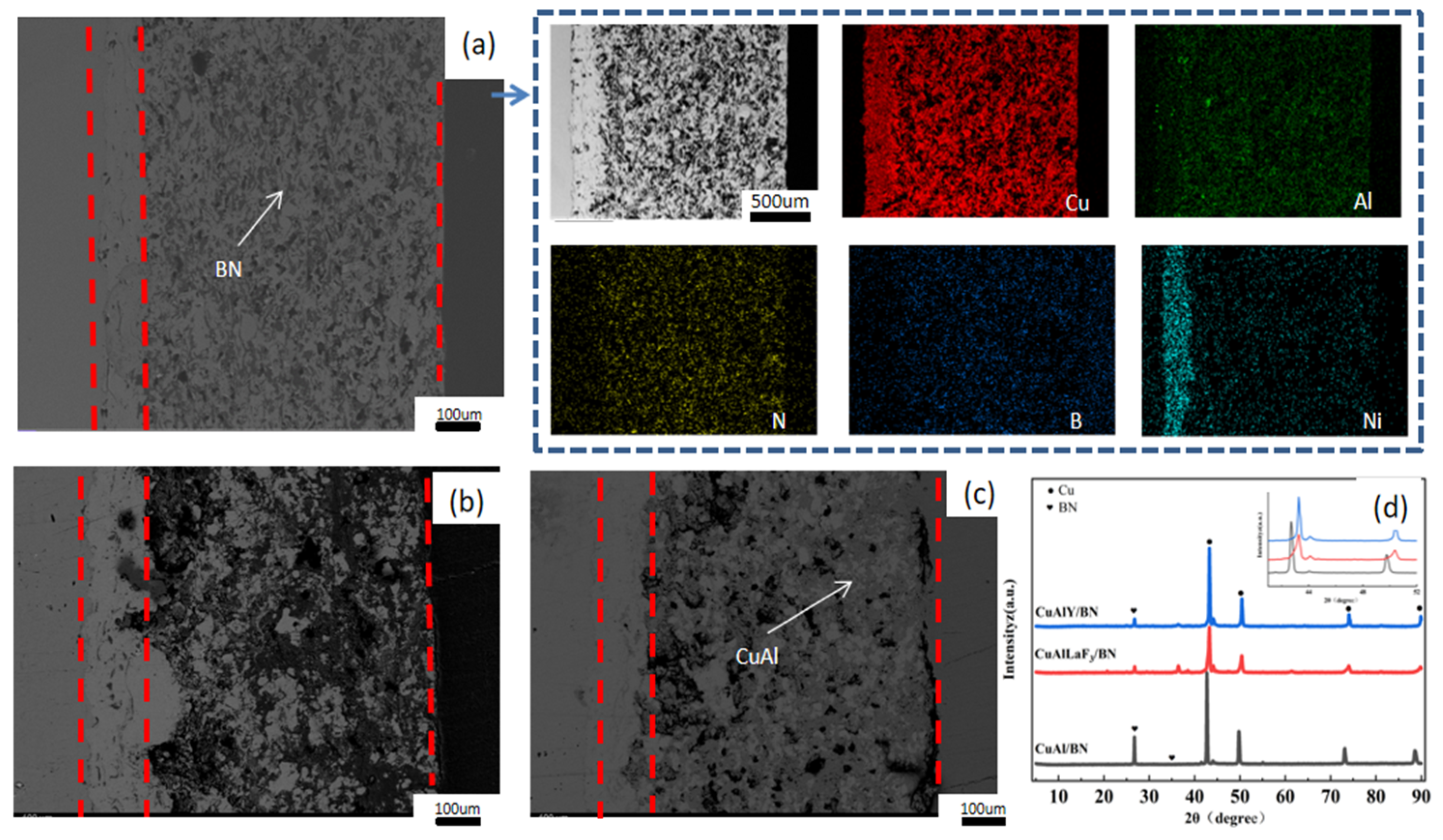

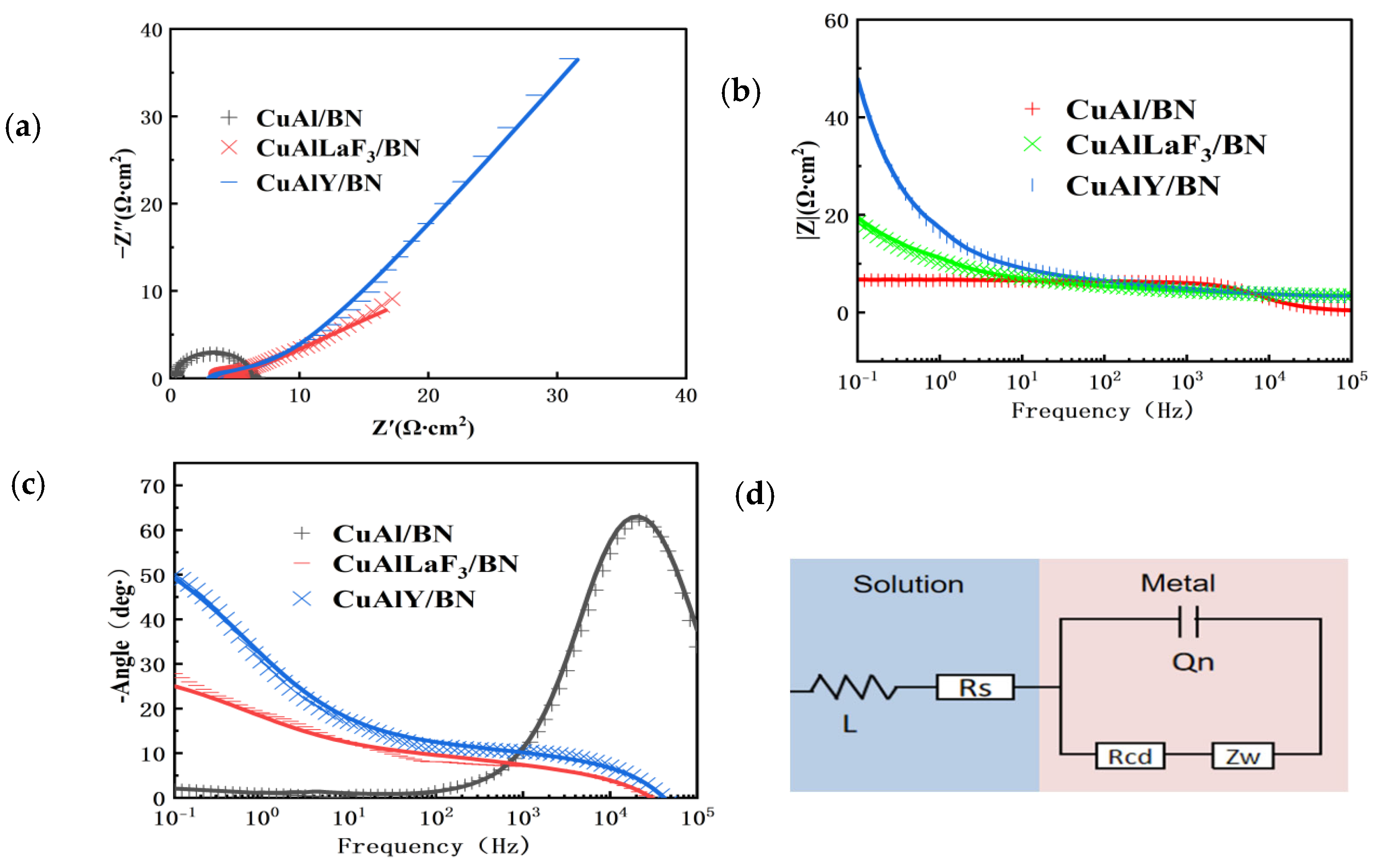

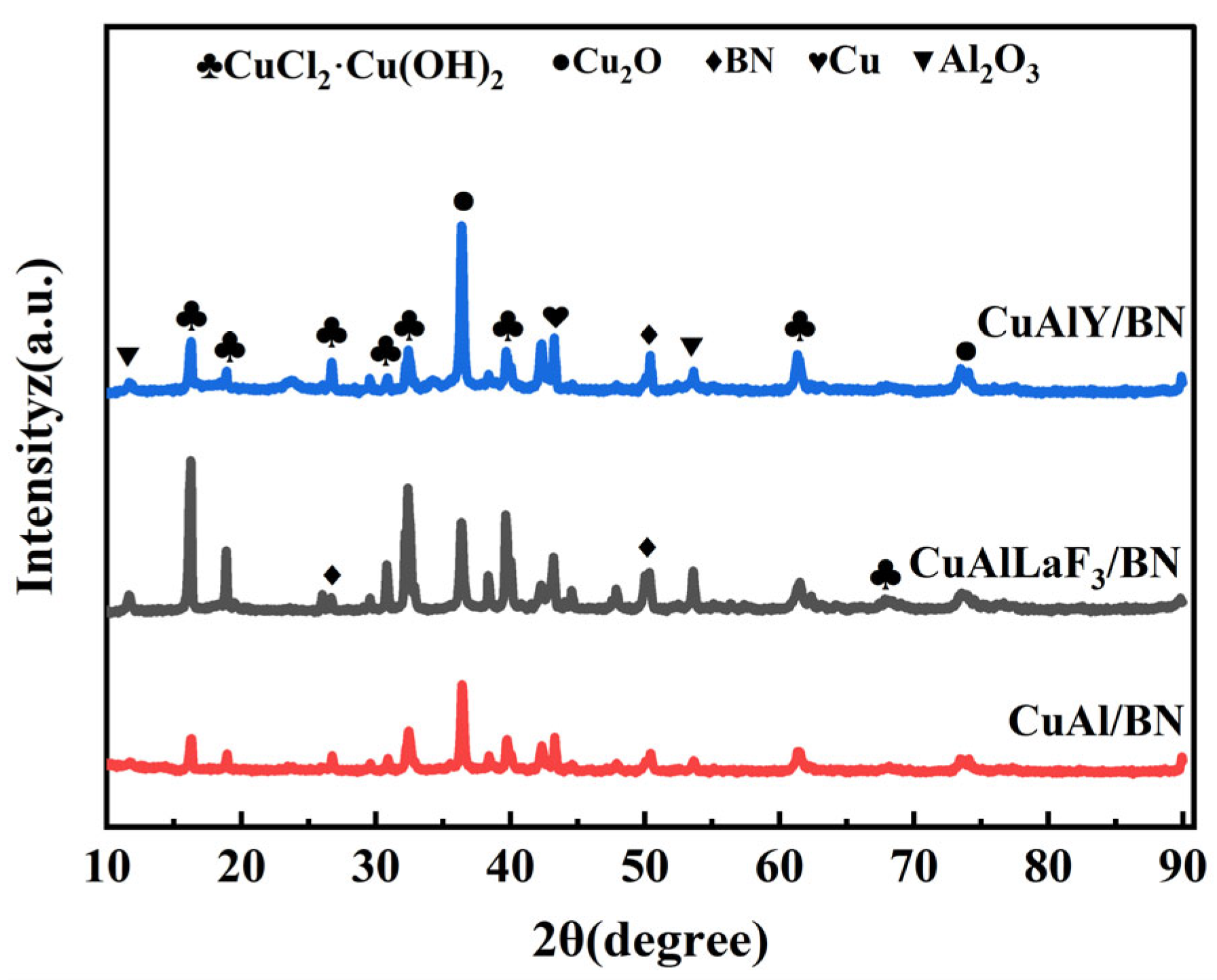
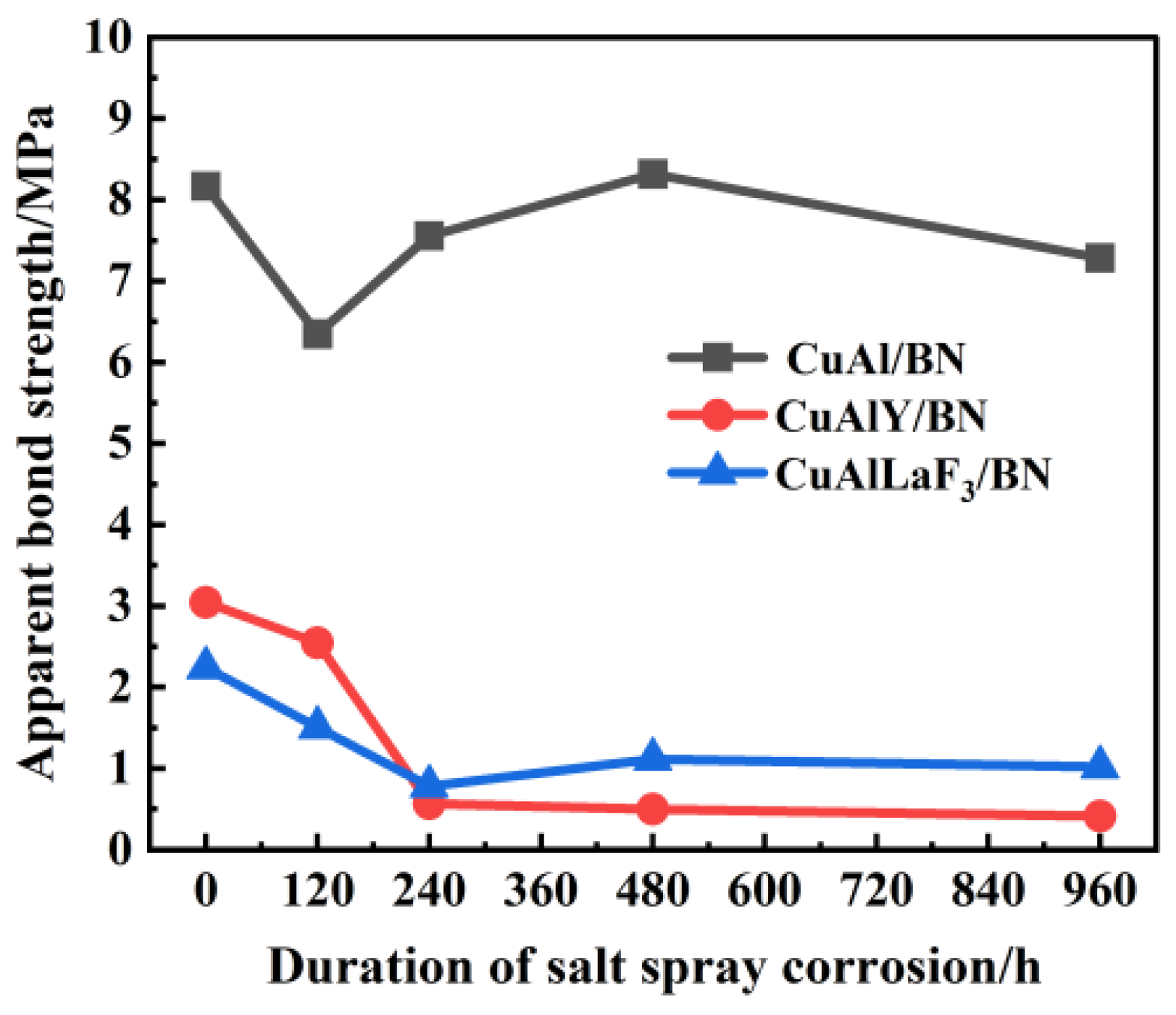
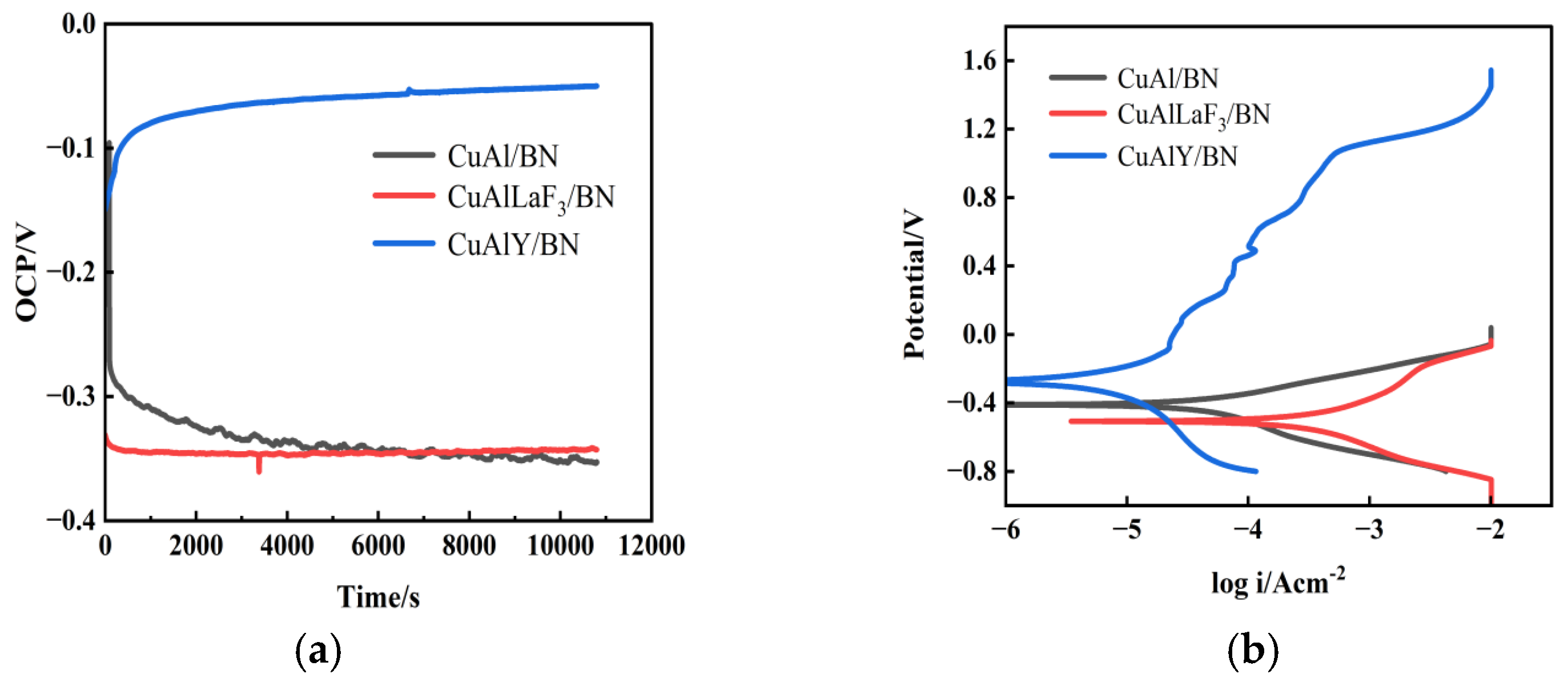
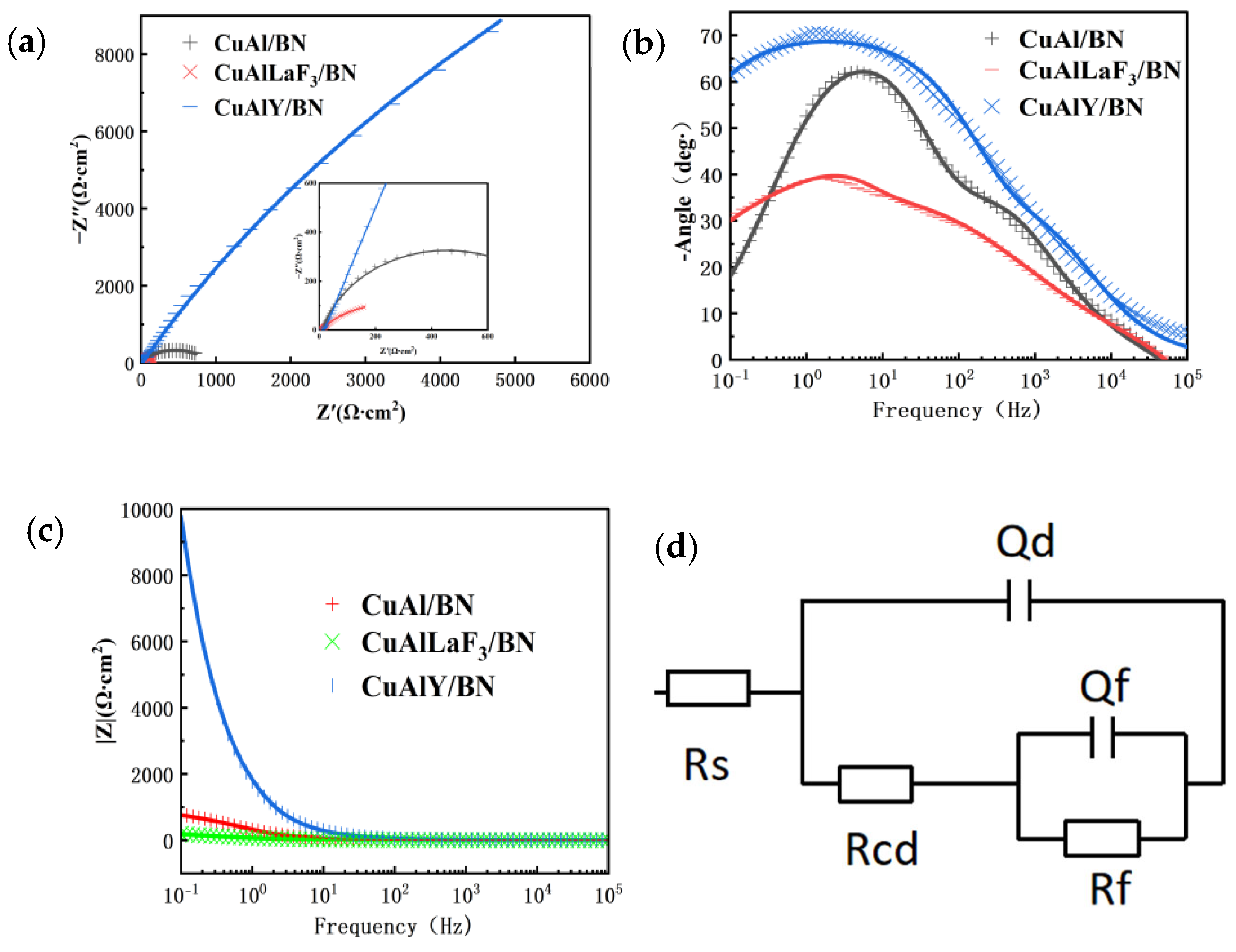
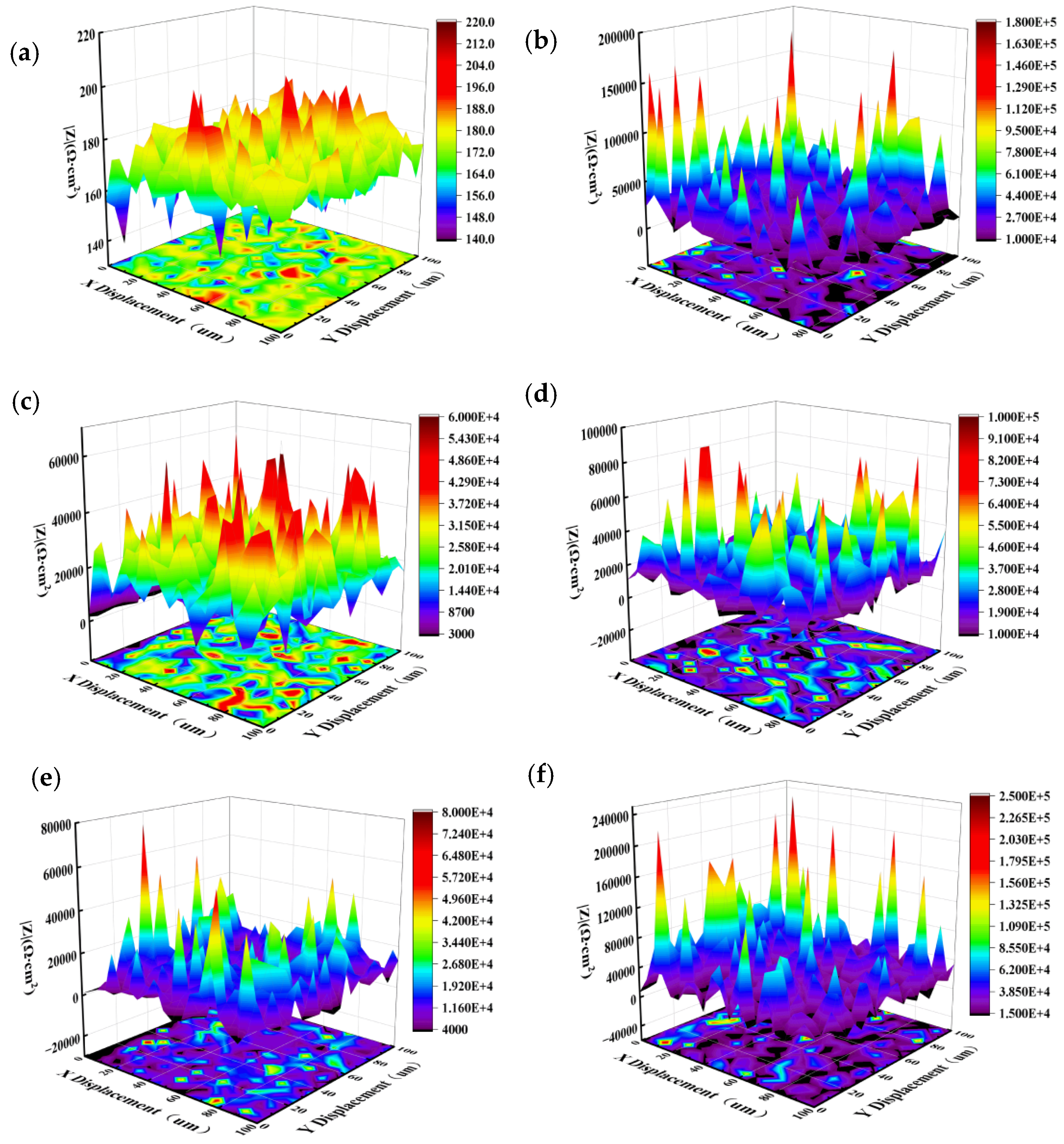
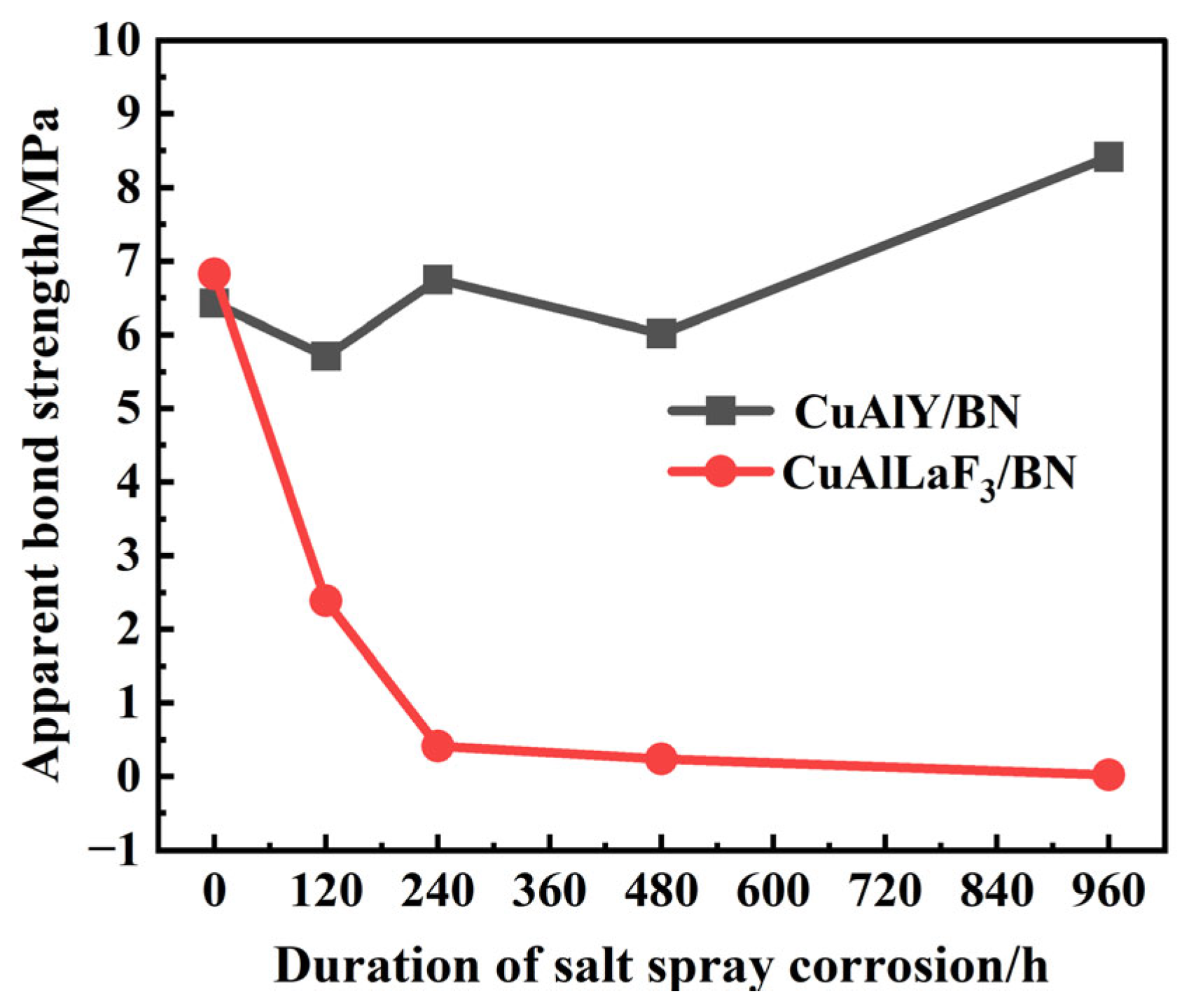
| Material | Cu | Al | Y | LaF3 | BN | Waterglass |
|---|---|---|---|---|---|---|
| CuAl/BN | 75 | 7.5 | --- | --- | 14.5 | 3 |
| CuAlLaF3/BN | 75 | 7.5 | --- | 0.75 | 14.5 | 2.25 |
| CuAlY/BN | 75 | 7.5 | 1.5 | --- | 14.5 | 1.5 |
| Current/(A) | Voltage (V) | Number of Shots Spray | Spray Distance (mm) | Ar Flow (L/min) | H2 Flow (L/min) |
|---|---|---|---|---|---|
| 400 | 57 | 15 | 100 | 40 | 2.0 |
| Material | Rsol (Ω∙cm2) | Rcd (Ω∙cm2) | Qn (F∙cm2) | n | Zw (Ω∙cm2) | Error/% | s2 |
|---|---|---|---|---|---|---|---|
| CuAl/BN | 0.36 | 5.96 | 5.55 × 10−6 | 0.99 | 0.876 | 3.76 | 1.41 × 10−3 |
| CuAlLaF3/BN | 2.96 | 1.43 | 4.52 × 10−2 | 0.29 | 0.037 | 3.95 | 1.57 × 10−3 |
| CuAlY/BN | 2.40 | 1.26 | 0.032 | 0.67 | 7.238 × 10−5 | 2.25 | 5.06 × 10−4 |
| Material | OCP (mV) | Icorr (uA/cm2) | Ecorr (mV/cm2) |
|---|---|---|---|
| CuAl/BN | −352.4 | 44.6 | −410.1 |
| CuAlLaF3/BN | −343.1 | 330.1 | −507.5 |
| CuAlY/BN | −50.4 | 4.1 | −269.9 |
| Material | Rsol (Ω∙cm2) | Rcd (Ω∙cm2) | Qd (F∙cm2) | n1 | Rf (Ω∙cm2) | Qf (F∙cm2) | n2 |
|---|---|---|---|---|---|---|---|
| CuAl/BN | 4.26 | 24.25 | 4.307 × 10−4 | 0.73 | 887.7 | 2.09 × 10−4 | 0.90 |
| CuAlLaF3/BN | 3.65 | 148.9 | 4.848 × 10−3 | 0.49 | 379.5 | 2.17 × 10−4 | 0.79 |
| CuAlY/BN | 10.01 | 30.95 | 6.421 × 10−5 | 0.77 | 6.2 E4 | 6.91 × 10−5 | 0.99 |
Disclaimer/Publisher’s Note: The statements, opinions and data contained in all publications are solely those of the individual author(s) and contributor(s) and not of MDPI and/or the editor(s). MDPI and/or the editor(s) disclaim responsibility for any injury to people or property resulting from any ideas, methods, instructions or products referred to in the content. |
© 2024 by the authors. Licensee MDPI, Basel, Switzerland. This article is an open access article distributed under the terms and conditions of the Creative Commons Attribution (CC BY) license (https://creativecommons.org/licenses/by/4.0/).
Share and Cite
Liu, Y.; Huang, C.; Yang, H.; Sun, X.; Zhang, H.; Sun, Y.; Zhang, W.; Lan, H.; Yu, S. Enhanced Corrosion Resistance of CuAl/BN Coatings through the Addition of Rare Earth Elements and High-Temperature Oxidation Treatment. Crystals 2024, 14, 808. https://doi.org/10.3390/cryst14090808
Liu Y, Huang C, Yang H, Sun X, Zhang H, Sun Y, Zhang W, Lan H, Yu S. Enhanced Corrosion Resistance of CuAl/BN Coatings through the Addition of Rare Earth Elements and High-Temperature Oxidation Treatment. Crystals. 2024; 14(9):808. https://doi.org/10.3390/cryst14090808
Chicago/Turabian StyleLiu, Yongjun, Chuanbing Huang, Hao Yang, Xiaoming Sun, Huifeng Zhang, Yonghui Sun, Weigang Zhang, Hao Lan, and Shouquan Yu. 2024. "Enhanced Corrosion Resistance of CuAl/BN Coatings through the Addition of Rare Earth Elements and High-Temperature Oxidation Treatment" Crystals 14, no. 9: 808. https://doi.org/10.3390/cryst14090808








